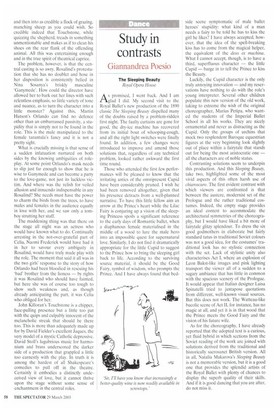Study in contrasts
Giannandrea Poesio
The Sleeping Beauty Royal Opera House
Asg promised, I went back. And I am lad I did. My second visit to the Royal Ballet's new production of the 1890 classic The Sleeping Beauty' dispelled many of the doubts raised by a problem-ridden first night. The faulty curtains are gone for good, the dry-ice machine has recovered from its initial bout of whooping-cough, and all the right light switches were finally found. In addition, a few changes were introduced to improve and amend those solutions that, regardless of any technical problem, looked rather awkward the first time round.
Those who attended the first few performances will be pleased to know that the irritating antics of the omnipresent Cupid have been considerably pruned. I wish he had been removed altogether, given that his presence detracts from a well-planned narrative. To have this little fellow aim an arrow at the Prince's heart while the Lilac Fairy is conjuring up a vision of the sleeping Princess spoils a significant reference to the early days of Romantic ballet, when a diaphanous female materialised in the middle of a wood to lure the male hero into an impossible quest for supernatural love. Similarly, I do not find it dramatically appropriate for the little Cupid to suggest to the Prince how to bring the sleeping girl back to life. According to the surviving source material, it should be the Good Fairy, symbol of wisdom, who prompts the Prince. And I have always found that bed side scene symptomatic of male ballet heroes' stupidity: what kind of a man needs a fairy to be told he has to kiss the girl he likes? I have always accepted, however, that the idea of the spell-breaking kiss has to come from the magical helper, the equivalent of the deus ex machina. What I cannot accept, though, is to have a third, superfluous character — the little Cupid — barge in to tell the Prince to kiss the Beauty.
Luckily, the Cupid character is the only truly annoying innovation — and my reservations have nothing to do with the role's young interpreter. Several other children populate this new version of the old work, taking to extreme the wish of the original choreographer, Marius Petipa, who wanted the students of the Imperial Ballet School in all his works. They are nicely ornamental and never as distracting as the Cupid. Only the groups of urchins that mock two resplendent Baroque equestrian figures at the very beginning look slightly out of place within a fairytale that stands out for being the most aristocratic one — all the characters are of noble status.
Contrasting solutions seem to underpin this production. And this Sleeping Beauty, take two, highlighted some of the most vivid aspects of this often harsh use of chiaroscuro. The first evident contrast with which viewers are confronted is that between the austere, modernist set of the Prologue and the rather traditional costumes. Indeed, the empty stage provides an ideal context to accommodate the architectural symmetries of the choreography, but I would have liked a bit more of fairytale glitzy splendour. To dress the six good godmothers in elaborate but fairly standard tutus in traditional Soviet colours was not a good idea, for the costumes' traditional look has no stylistic connection with the set. Lack of stylistic unity also characterises Act I, where an explosion of Leon Bakst-like images and pink lighting transport the viewer all of a sudden to a sugary ambiance that has little in common with the spacious scenery of the Prologue. It would appear that Italian designer Luisa Spinatelli tried to juxtapose quotations from different, well-known visual sources. But this does not work. The Watteau-like bucolic scene of Act II, for instance, has no magic at all, and yet it is in that wood that the Prince meets the Good Fairy and the vision of his future wife.
As for the choreography. I have already reported that the adopted text is a curious, yet fluid hybrid in which sections from the Soviet reading of the work are joined with solutions derived from the traditional and historically sacrosanct British version, All in all, Natalia Makarova's Sleeping Beauty is not a memorable version, but it is a good one that provides the splendid artists of the Royal Ballet with plenty of chances to display the superb quality of their skills. And if it is good dancing that you are after, do not miss it.








































































 Previous page
Previous page